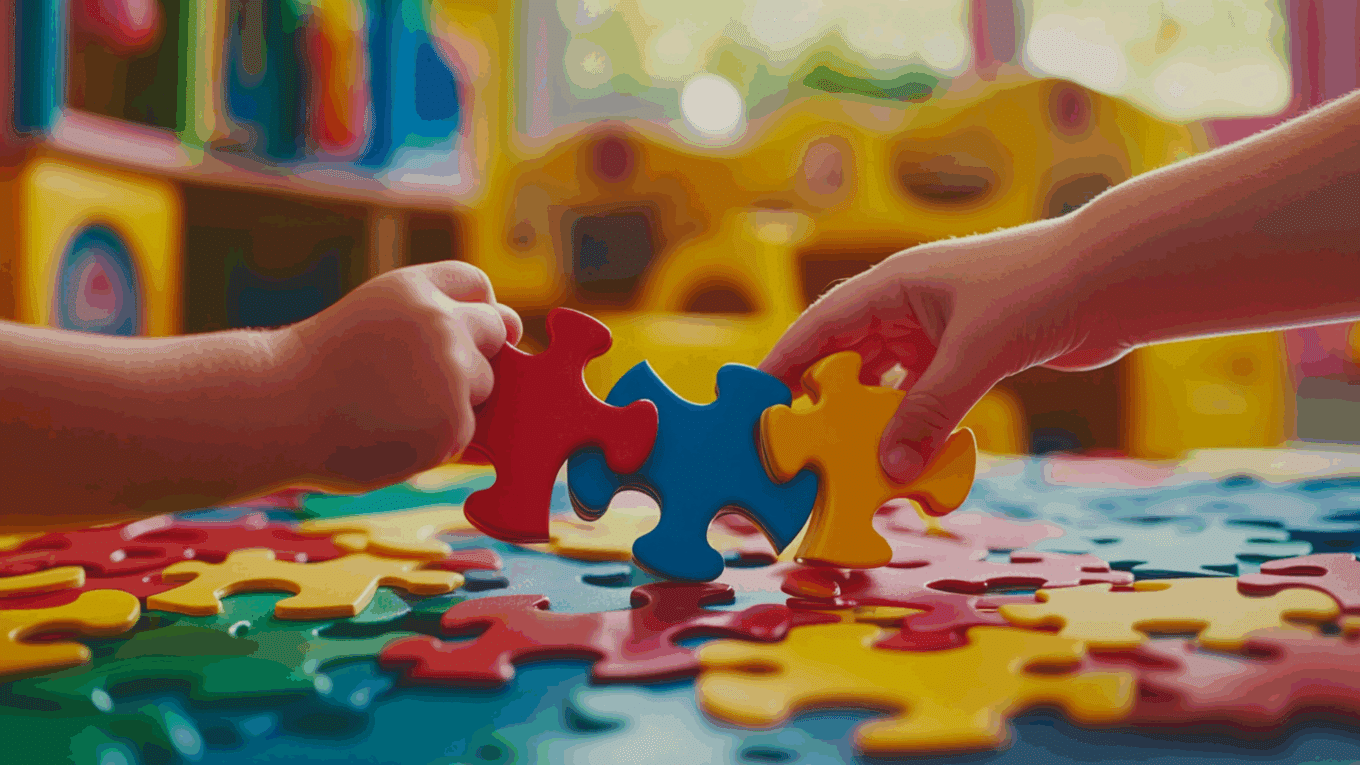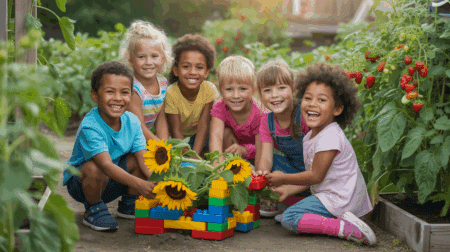Kids often struggle with handling disagreements at school and at home. They lack the tools to solve problems without tears, tantrums, or tattling.
Parents and teachers need simple conflict resolution activities for kids that work in real situations. This blog offers practical solutions that help children develop healthy communication skills without complex therapy techniques.
Readers will find tested activities divided into age groups, along with tips for implementation in classrooms and family settings.
These exercises teach kids how to express feelings, listen actively, and find win-win solutions.
Why Are Conflict Resolution Activities for Kids Important?
Conflict resolution skills shape a child’s future success in ways many adults don’t realize. Learning to handle conflicts helps children do better in school. Studies show kids who can manage disagreements pay more attention in class and work better in groups.
Children who practice conflict resolution:
- Understand their own feelings better
- Recognize emotions in others
- Build stronger friendships
These activities also create safer school environments by reducing bullying incidents. When children know how to speak up and set boundaries, they’re less likely to become targets or bullies themselves.
At home, families who practice conflict resolution together report fewer stressful mealtimes and bedtimes. The skills learned through structured activities carry over into everyday interactions.
Tips for Parents and Teachers to Support Conflict Resolution
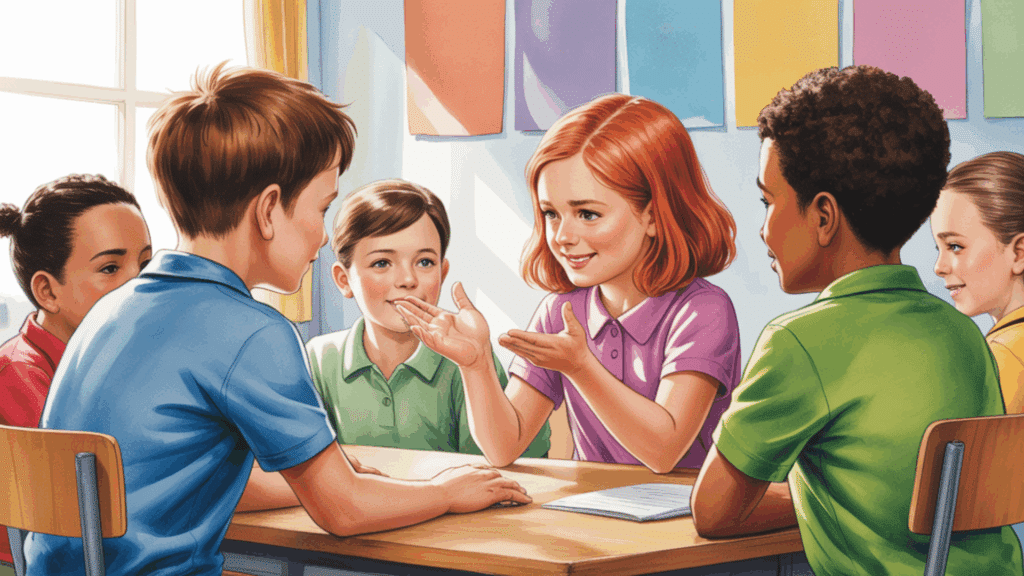
Parents and teachers play a vital role in helping children steer disagreements and build healthy relationships.
By modeling effective communication and providing structured guidance, adults can create a supportive environment for learning conflict resolution activities for kids.
- Active listening: Show children how to listen carefully to each other by making eye contact and repeating back what they hear. This helps everyone feel understood and valued.
- Emotion labeling: Encourage kids to name their feelings before discussing a problem. Identifying emotions like anger, frustration, or sadness helps children manage their reactions more calmly.
- Calm-down spaces: Set up a quiet area where children can go to cool off when emotions run high. This gives them time to regain control before working through a conflict.
- Use of “I” statements: Teach children to express their feelings and needs using “I” statements, such as “I feel upset when…” This reduces blame and encourages honest communication.
- Modeling respectful behavior: Demonstrate how to disagree politely and respect different opinions. Children learn by observing adults handle conflicts with patience and empathy.
- Guided problem-solving: Walk children through the steps of identifying the problem, brainstorming solutions, and choosing the best option together. This approach builds independence and cooperation.
- Positive reinforcement: Praise children when they resolve conflicts peacefully or use new skills. Recognition motivates them to continue practicing healthy conflict resolution.
Conflict Resolution Games for Children
Helping children negotiate disagreements with empathy and understanding is key to nurturing strong social skills. Conflict resolution activities for kids offer a hands-on way to develop patience, listening, and problem-solving.
These games encourage teamwork, open communication, and respectful negotiation through play. Readers can find a list of engaging activities that turn tension into teachable moments, fun included.
Play-Based Solutions That Teach Teamwork
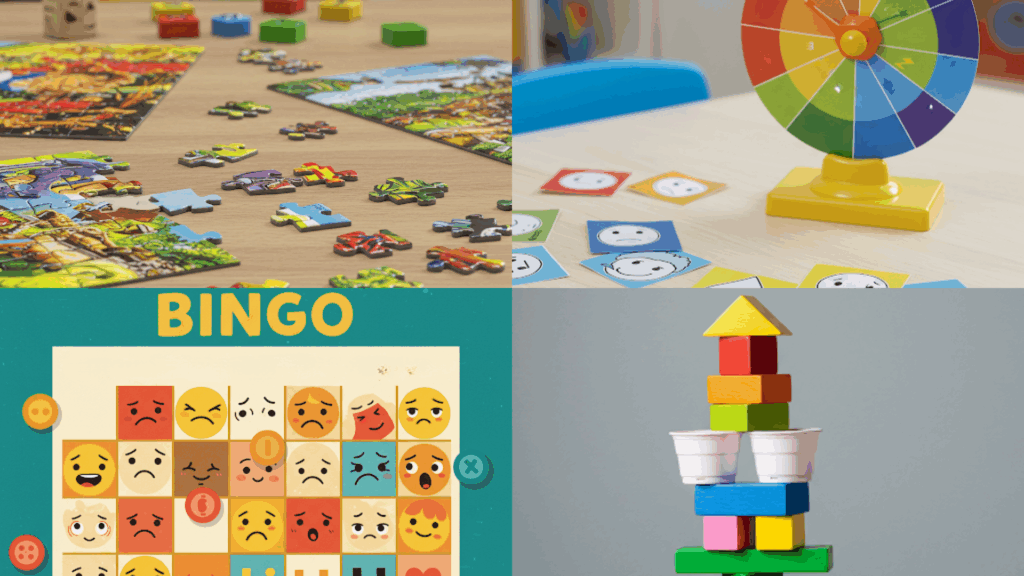
1. Peace Puzzle
Children are divided into teams and given puzzles, but some pieces are hidden with other teams. To complete the puzzle, they must communicate and negotiate with one another.
This encourages problem-solving through cooperation rather than competition. It also strengthens group interaction and conflict resolution skills in a playful setting.
2. Emotion Statues
Call out various emotions like joy, anger, or surprise, and have children freeze into a statue representing that feeling. The group guesses the emotion and discusses times they’ve experienced it.
This activity helps kids recognize emotional cues and express themselves physically. It also promotes empathy by encouraging kids to understand others’ emotional states.
3. Conflict Charades
Kids act out simple disagreements like not taking turns or grabbing toys, while others guess the scenario. After the guessing, they talk about better ways to handle the situation.
This opens up healthy conversations about real-life challenges. It teaches emotional expression, empathy, and solution-oriented thinking.
4. The Compromise Relay
In pairs, kids are asked to complete a task such as carrying a ball using only one finger each. To succeed, they must strategize and work closely together, adjusting to each other’s style.
The activity emphasizes how compromise and listening can lead to success. It also encourages patience and shared responsibility.
5. Whisper and Pass
Children sit in a circle and pass a whispered message related to kindness or peace around the group. When the last child says it out loud, the group compares it to the original message.
This shows how messages can get distorted and how misunderstandings happen. It encourages clarity in communication and reinforces the importance of listening carefully.
6. Agree or Disagree Corners
Read out a statement like “It’s okay to shout when you’re angry” and assign corners for Agree, Disagree, and Unsure. Kids move to the corner that represents their view and share why.
This opens up respectful discussions on differing opinions. It teaches kids to express their perspectives while learning to hear others out.
7. Conflict Dice
Create a large dice with different strategies like “Take a deep breath” or “Use kind words.” Kids roll it and use the chosen action to resolve a pretend argument.
This introduces them to various resolution tools in a playful way. Over time, these responses become second nature in real-life situations.
8. Kindness Musical Chairs
Instead of removing chairs, have children say something kind to the person beside them when the music stops. This keeps everyone included while fostering positive social interactions.
It turns a competitive game into a celebration of kindness. The focus shifts from winning to connecting and appreciating others.
9. Freeze and Rewind
Children act out a conflict situation, then freeze at the most intense moment. The group discusses what could be done differently, and the actors “rewind” and try a better response.
This teaches reflection and encourages kids to evaluate their actions. It turns mistakes into learning opportunities in a creative, engaging way.
10. Mirror Me
In pairs, one child performs slow movements while the other mirrors them exactly. The silent activity requires concentration and trust between partners.
Afterward, they discuss what helped or made it hard to stay connected. It builds patience, focus, and sensitivity to others’ cues.
11. Yes, And… Game
Kids create a collaborative story, where each sentence must begin with “Yes, and…” to build on the last idea. This eliminates negative responses and encourages constructive conversation.
It teaches acceptance, cooperation, and imagination. The game naturally models how to move a conversation forward positively.
12. Emotion Uno
Assign an emotion to each color in Uno, such as red for anger or blue for sadness. When a player lays down a card, they share a moment they felt that emotion.
It combines gameplay with emotional literacy. Kids learn to identify and express their feelings comfortably.
Communication Boosters in Action
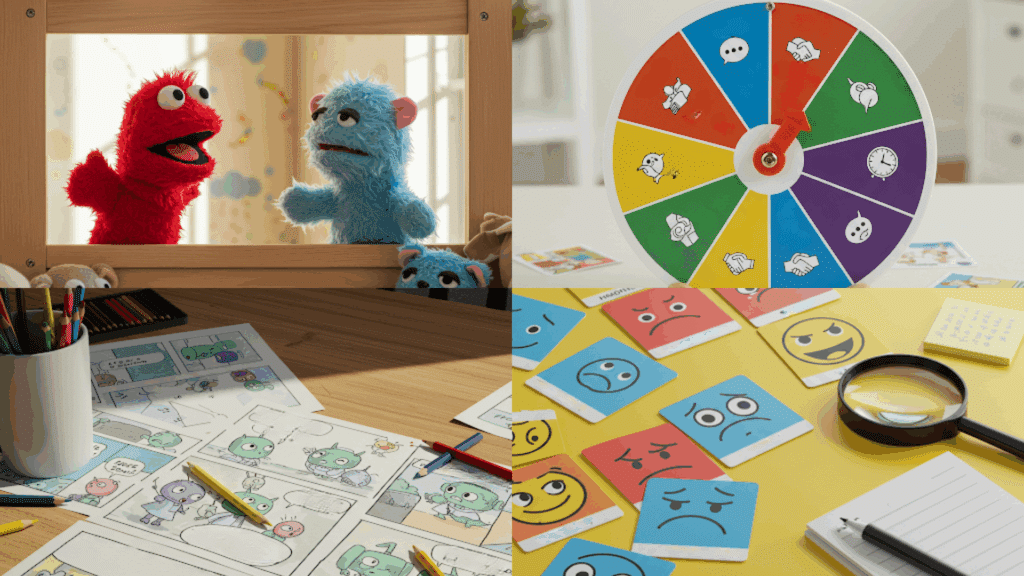
13. Feelings Detective
Each child selects an emotion card in secret and acts it out using only facial expressions and gestures. The rest of the group guesses the emotion and explains why they think so.
This sharpens observation and interpretation of non-verbal cues. It also helps kids become more aware of how feelings are expressed and seen.
14. Solution Scavenger Hunt
Write conflict-solving strategies on cards and hide them around the room. Kids find the cards and match them to pretend problems displayed on a board.
This activity blends movement with thinking and reflection. It helps children identify a variety of peaceful solutions in a hands-on way.
15. I-Messages Practice
Teach kids to use phrases like “I feel sad when you take my toy without asking” instead of blaming. Practice scenarios together and role-play how to say these messages respectfully.
This skill builds emotional ownership and assertiveness. It reduces escalation by focusing on personal feelings rather than accusations.
16. Conflict Comic Strips
Kids draw a short comic strip showing a disagreement and how it was peacefully resolved. They can present their strips to the group and explain the characters’ choices.
This taps into creativity and reflection. It allows children to visualize both the problem and the positive outcome.
17. Empathy Walk
Children are assigned roles in imagined situations, like being excluded or misunderstood. They explain how that character might feel and how others could help.
This encourages emotional connection and consideration of different viewpoints. It helps children relate to others’ experiences more deeply.
18. Listening Balloon
Pass a balloon around the group and only the child holding it may speak. Everyone else must stay quiet and listen closely.
This activity teaches respectful turn-taking and reinforces the value of being heard. It helps children slow down and truly focus on others’ words.
19. Feelings Bingo
Create bingo cards with various emotions like excited, nervous, or frustrated. Read out real-life scenarios and kids mark how they think they’d feel in each case.
This game connects emotional understanding with everyday experiences. It makes talking about feelings fun and familiar.
20. Two Truths and a Trouble
Each child shares two good things and one challenge they recently faced. Others offer supportive advice or solutions for the trouble.
This builds trust and emotional openness within the group. It also teaches that seeking help is a strength, not a weakness.
21. Silent Building Challenge
Kids are grouped and asked to build a tower or structure using blocks without speaking. They must rely on gestures, eye contact, and cooperation to complete the task.
Afterwards, the group reflects on how they handled the challenge. It builds non-verbal communication and team problem-solving.
22. Puppet Talks
Use puppets to act out common kid conflicts like toy-sharing or interrupting. Children then suggest alternative responses for the puppets to try.
This removes pressure by using characters instead of themselves. It makes exploring emotional topics less intimidating and more playful.
23. Who Said It Kinder
Give two versions of the same sentence, one spoken kindly and one rudely. Kids decide which is better and why.
This builds awareness of tone and word choice. It encourages thoughtful speech and teaches kids how delivery affects others.
24. Back-to-Back Drawing
Pair up kids and have one describe a picture while the other draws it without seeing. This helps them practice giving clear directions and listening carefully.
When they compare results, they discuss what was clear or confusing. It highlights the importance of precision in communication.
25. Conflict Match-Up
Prepare cards with common kid conflicts on one side and solutions on another. Kids match the problem with the right resolution.
They then explain why they made the match. This reinforces practical responses and helps children think critically about choices.
26. Mindful Moment Jar
Create a jar filled with small slips suggesting calming actions like breathing deeply or counting to ten. Kids pull one out when they feel overwhelmed.
This teaches emotional regulation in the heat of the moment. It empowers them to take responsibility for calming down before resolving issues.
Creative Role-Play to Practice Empathy
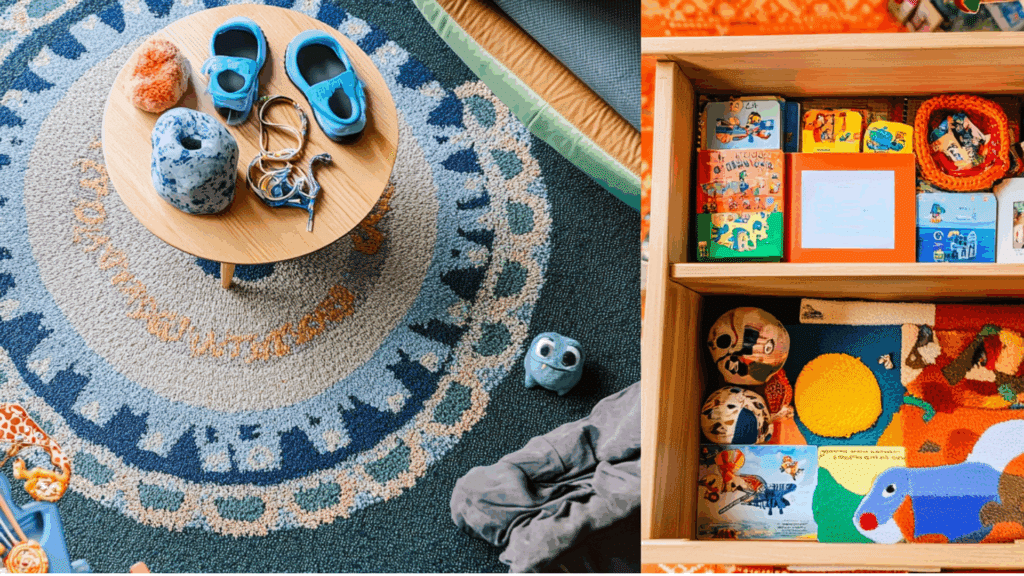
27. Switch Shoes
28. Peace Table
29. Fairness Freeze Frame
30. Pet Peeve Theater
31. The Rewind Game
32. Pass the Problem
33. Judge Kindheart
34. Conflict Photo Cards
35. Role-Reversal Day
36. Emotion Costume Box
37. Peace Breathing
38. Gratitude Circles
39. Calm Down Corners
40. Conflict Journaling
41. Resolution Tree
42. Peace Promises Poster
43. Self-Talk Practice
44. Feelings Wheel Spin
45. Weekly Reflection Circles
Essential Conflict Handling Modes
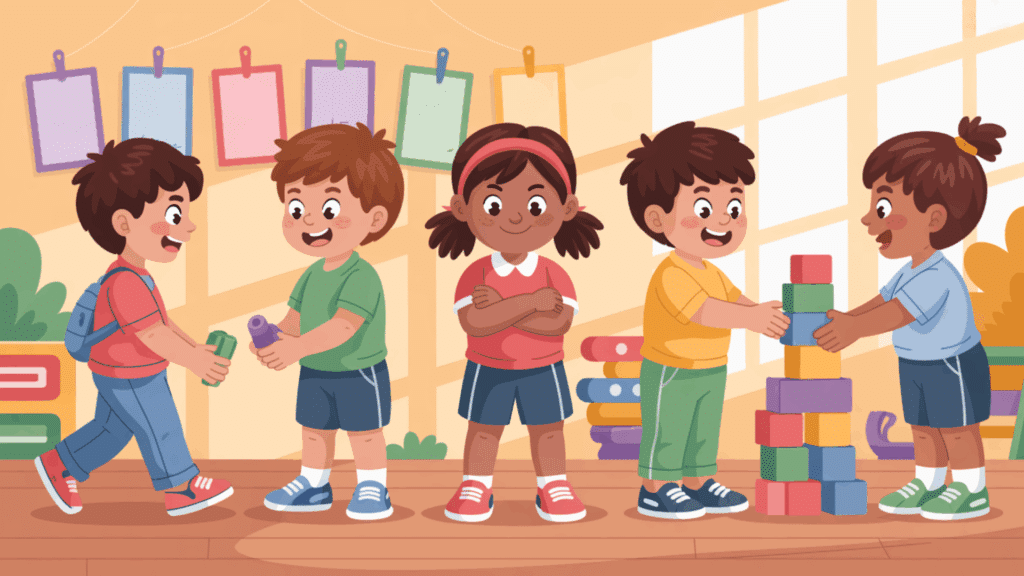
Children handle conflicts in different ways based on their personalities and past experiences. Not all methods work equally well in every situation.
Some approaches build friendships while others can damage them. Understanding these five basic modes helps adults guide kids toward better choices during disagreements.
1. Avoiding: Children try to stay away from conflict completely. They might walk away, change the subject, or pretend nothing happened. This works for minor issues but doesn’t solve the real problem.
2. Accommodating: Kids give in to keep others happy. These children put others’ needs first, even if it means not getting what they want. While this seems kind, it can lead to feelings of unfairness over time.
3. Competing: Children try to win at all costs. They push their own ideas and aren’t willing to compromise. This approach often causes more problems than it solves.
4. Compromising: Children meet in the middle. Each person gives up something to find a solution. This works well for quick fixes but might not fully satisfy anyone.
5. Collaborating: Children work together to find solutions that meet everyone’s needs. This takes more time but creates the best long-term results and teaches valuable skills.
Summing It Up
Conflict resolution activities for kids provide lasting benefits that extend far beyond childhood. When children learn to handle disagreements with respect and open communication, they build foundation skills for future relationships.
These techniques help them steer social situations with confidence instead of fear or aggression.
Parents who invest time in practicing these activities often notice improved behavior at home, while teachers report more peaceful classrooms.
Every skill children learn through these exercises becomes part of who they grow to be.

